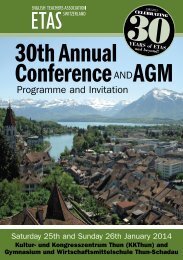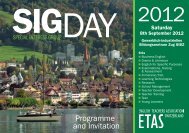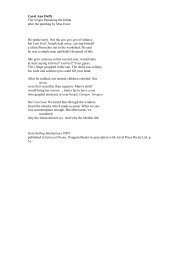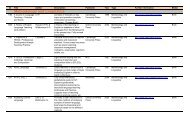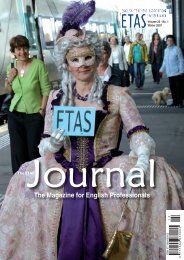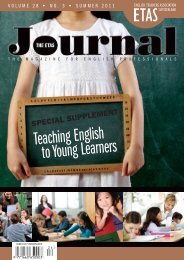ETAS 29th AGM and Convention SupplementWorkshop ReportsA8Testing and assessingspoken <strong>English</strong> – how canwe do it better?Presenter: Dave AllanTake over 30 experienced <strong>English</strong>-teachingpr<strong>of</strong>essionals who are interested in thetopic <strong>of</strong> oral assessment, put them in a bigroom, and have them judge the level <strong>of</strong> twocandidates doing a speaking exam. Whatdo you get? Brace yourself – results rangingfrom A2 all the way up to B2. In otherwords, total lack <strong>of</strong> consensus. Should webe worried? I was!This exercise opened our eyes to howdifferently and subjectively we interpretspeaking performance. Yes, we have comea long way with the CEFR: ten years ago,few <strong>of</strong> us would have known what it was;five years ago, most <strong>of</strong> us might have heard<strong>of</strong> it, and today most <strong>of</strong> us do in fact usethis framework <strong>of</strong> REFERENCE (emphasisadded). However, Dave argued that theCEFR is not nearly discriminatory enoughto judge language performance with thedelicacy we <strong>of</strong>ten need and that criteria inthe form <strong>of</strong> more detailed verbal descriptorsare needed if we are to evaluate spoken<strong>English</strong> in a meaningful and consistent wayin many contexts where we need to assessprogress and pr<strong>of</strong>iciency within levels.Fortunately, Dave provided us with severaldifferent models. He noted that trainingassessors who used such additional criteriaand followed extensive familiarisation andpractice have achieved levels <strong>of</strong> inter-raterreliability as high as 0.92 – it is reassuringfor those <strong>of</strong> us sending our students toexams. In just 90 minutes, we couldn’t quiteachieve that same remarkable level, butthere were some obvious lessons to learn.Many <strong>of</strong> us are still focusing too much onthe negative, i.e. what the candidate isdoing wrong. This opened the question <strong>of</strong>error weighting – do we see the same errorrepeated <strong>of</strong>ten as being less serious thana series <strong>of</strong> several different errors? Whatwould happen if we focused first on whatthe candidate was doing well?Using a set <strong>of</strong> agreed macro-categoriesand starting at the top (looking first at thecriteria in the highest box in the grids)already helped us obtain closer resultswithin the workshop group.The CEFR is great but it is not enough byitself for many contexts. Anyone involvedin oral assessment needs to use carefullydeveloped tools whose descriptors focusspecifically on the key components <strong>of</strong>spoken language communication, ensuringcoverage <strong>of</strong> both ‘presentation mode’production and the skills needs (includinglistening skills) for effective interaction.I highly recommend this workshop berepeated in future – it’s a must for anyonewho has ever had to judge someone’soral <strong>English</strong>. Thanks to Dave and all theopen-minded participants for an enrichingtime together.Sylvia GoetzeA9 &B9Truce or friction: learning theart <strong>of</strong> successful negotiationPresenter: JoAnn SalvisbergJoAnn Salvisberg presented a lively two-partworkshop on how to teach negotiation inlanguage classes. The first workshopfocused on the stages <strong>of</strong> a successfulwin-win negotiation, while the seconddealt with the language gambits involvedin the process.JoAnn began by pointing out that we spenda great deal <strong>of</strong> time negotiating – and thisfrom a very early age. She went on to saythat we don’t just negotiate with others,but also frequently have to “trade <strong>of</strong>f”with ourselves.She presented five categories <strong>of</strong> negotiation,ranging from “casual” (the kind <strong>of</strong>negotiating we do as children, for example)to “critical” (when the consequences <strong>of</strong> abreakdown in the discussion can havefar-reaching consequences). JoAnn alsoexplained that negotiating takes on a variety<strong>of</strong> forms – from haggling over the price <strong>of</strong>food items at a market to formal businessand diplomatic discussions. Depending onthe projected outcome <strong>of</strong> the process,negotiations are classified as “adversorial”(win-lose), “accommodating” (lose-win),“compromising” (give-get), “collaborative”(win-win), “distributive” (win-lose), or even“integrative” (when the process itselfcreates value). Dialogue is naturally crucialin all cases, and JoAnn showed us somecommon strategies. Specialists, forinstance, caution against closed questions(“Could you do the job for £15?”) and,unsurprisingly perhaps, recommend the use<strong>of</strong> conditional forms. What is slightly moresurprising is that it is not the tentativewould they have in mind, but the far moredirect first conditional: “If you do the job for£15 [instead <strong>of</strong> £20], I’ll supply you with alist <strong>of</strong> potential clients.”The second workshop explored in greaterdetail the range <strong>of</strong> expressions (gambits)which can usefully be deployed in anegotiation (e.g. “I’d like to hear your viewson…”; “Would I be correct in saying that…?”;“We’re prepared to…”; “I wonder if you’veconsidered…?”). JoAnn also provided uswith practical ideas on how to get studentsthinking about the general principlesbehind successful negotiations (weparticipated in a business role-play), aswell as some interesting ways <strong>of</strong> practisingthe key language.In conclusion, I’d like to thank JoAnn fortwo valuable workshops, which wereappreciated by everyone. On the one hand,they provided advice to teachers like me whoare about to give courses on negotiation;and on the other, they gave the moreseasoned practitioners in the audiencesome very interesting food for thought.Guy WalkerA10Developing listeningskills means developingpronunciationPresenter: John HughesJohn Hughes’s workshop was awell-attended and lively 90 minutes on theSaturday afternoon <strong>of</strong> the ETAS AGM andConvention <strong>2013</strong>. His main presentationfocused on the need to introducepronunciation as an overt part <strong>of</strong> listeninglessons when teaching <strong>English</strong>, and bydemonstrating some <strong>of</strong> his techniques,he made the session interactive andentertaining, as well as informative.John began by saying that most students<strong>of</strong> <strong>English</strong> are more capable <strong>of</strong> listeningcomprehension than we suppose, but areheld back by simple misunderstanding <strong>of</strong>pronunciation. Our students have theknowledge to interpret “What time is it?”on a recording, but <strong>of</strong>ten fail to recognisethe actual words that they are hearingbecause pronunciation <strong>of</strong> the spoken wordis not understood.30 ETAS <strong>Journal</strong> 30/2 <strong>Spring</strong> <strong>2013</strong>
ack <strong>of</strong> the mouth (for example,/p – b – t – d – ʧ – ʤ – k – g/).By examining a variety <strong>of</strong> accents, withcontributions from many <strong>of</strong> the attendees,John demonstrated how difficult listeningcomprehension can be, given the range<strong>of</strong> accents which our students may beexpected to understand. Suggestedtechniques to help deal with the spokenword included ‘humming’ dialogue, asurprisingly effective way to circumventpronunciation difficulties. Jazz chants werealso used as a way to help students. Thewhole audience was roundly entertained,especially by the interactive exercises whichdemonstrated how to convey intonation,mood, and word and sentence stress.Fun apart, John addresses a seriousproblem for learners <strong>of</strong> <strong>English</strong>. He suggeststhat listening exercises should not be simplerepetitions <strong>of</strong> a recording, with pauses forcomprehension checks, but ratherinterspersed with exercises and activitiesaimed at improving comprehension, throughimproving the ability to understand theactual pronunciation.In summing up, John added that videorecordings, rather than audio-only, are apowerful tool in overcoming pronunciationdifficulties, because they can include all <strong>of</strong>the signs and signals that body languageand facial expression convey.Overall, this session provided valuableinsights and suggestions into how <strong>English</strong>learners deal with listening pronunciationdifficulties, and how we as teachers canhelp in that process. Thanks go to Johnfor the ideas, energy, and fun, but most <strong>of</strong>all for the food for thought!Susan Codringtoncoax your students into learning them – youmight agree that <strong>English</strong> phonologysometimes needs to be demystified.Adrian began his workshop with a passionatespeech in defence <strong>of</strong> pronunciation, “theCinderella <strong>of</strong> the language systems”,arguing that pronunciation infuses alllanguage and even cognitive skills, as wetend to pronounce words to ourselves notonly when reading or listening but also whenformulating our thoughts or memorizinginformation. And yet, pronunciation is <strong>of</strong>tenreduced to five-minute activities at theend <strong>of</strong> a unit, outshone by her two “uglysisters”, Grammar and Vocabulary.In order to bring pronunciation back to allclassroom work, we can:1) provide our students with the phonemicchart as a ‘roadmap’ which shows inwhat part <strong>of</strong> the mouth each sound isproduced (in the front or in the back, atthe top or at the bottom)2) teach pronunciation as a physicalactivity (rather than cognitively), payingattention to four “muscle buttons”:tongue put forward or back, lipsspreading or rounded, jaw and tonguegoing up or down, voice turned “on”or “<strong>of</strong>f”.(See more detailed explanations inAdrian Underhill’s article atwww.britishcouncil.org/a_new_approach_to_pronunciation.docor on his blog:http://adrianpronchart.wordpress.com/)A quick-paced tour <strong>of</strong> the chart followed.We moved from “top left” vowels to“top right” (/i: - ɪ – ʊ – u:/), “centre”and “bottom” vowels, then pronounceddiphthongs and finally covered consonantsin the same order, from the front to theTo learn about Adrian Underhill’s originalpronunciation teaching technique, you canwatch the <strong>of</strong>ficial one-hour video <strong>of</strong> one <strong>of</strong>his seminars at http://www.youtube.com/watch?v=f5RekixAMoM. However, here area few interesting tips that he shared:1) The teacher mimes a sound andenhances it with a gesture andsometimes a situation to imagine(“You’ve got an orange in your mouthso you can’t close it!”). Students firstprepare the position for the sound totake place, then pronounce itresponding to the teacher’s gesture.Only then does the teacher pronouncethe sound themself!2) In the same way, sometimes it’s usefulto ask students not to pronounce butjust to mime a sound.3) Students can compare sounds usinggestures, e.g. pressing a finger againsttheir lips to see if they are pushedforward.4) Individual differences in pronunciationcan be celebrated: “Listen to allthese /ɜ:/”!All this helps to raise students’ awareness<strong>of</strong> how and where sounds are actually made.Instead <strong>of</strong> imitating and drilling sounds, theycan now experiment with them. They literallyknow what they are doing when theypronounce a sound – and this is when thewhole chart stops being yet another thing tolearn and becomes a clear and useful tool.Thank you, Adrian, for a wonderful andhighly inspiring workshop!Anel Aubert© Macmillan <strong>English</strong>B1A practical approach tointegrating pronunciationinto all language workPresenter: Adrian UnderhillAdrian Underhill, the renowned author <strong>of</strong>Sound Foundations: Learning and TeachingPronunciation (Macmillan Education, 2005),devoted his workshop to “demystifyingphonology”. If you’ve ever used IPA(International Phonetic Alphabet) rune-likesymbols in a classroom – let alone tried toETAS <strong>Journal</strong> 30/2 <strong>Spring</strong> <strong>2013</strong> 31



